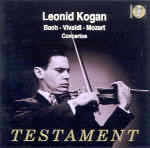Leonid Kogan was one of several Soviet artists who burst upon the Western classical music scene in the mid-1950s, astonishing all with their incredible technique and superior musicianship. At the time–and ever since–Kogan played second fiddle to David Oistrakh, in much the same position occupied by Emil Gilels in relation to Sviatoslav Richter among pianists. At 26, Kogan won the 1951 Ysaye Competition (Oistrakh was on the jury) and then was unceremoniously ordered back to the Soviet Union instead of enjoying a triumphant European tour. He didn’t make his London and Paris debuts until 1955. Testament’s six-disc series of Kogan’s mid-1950s British and European recordings offers a welcome opportunity to supplement his hard-to-find Soviet releases, and if much of the repertoire duplicates those, it’s in appreciably better sound.
The first of the series offers Kogan in Baroque and Classical works, which prove congenial to his naturally aristocratic approach. In the Bach Concerto for Two Violins, which opens the program, he’s joined by his wife, Elizaveta Gilels, the pianist’s sister. With Otto Ackermann conducting, the performance has a pleasing solidity, neither Bach-lite in the current style nor stolidly heavy as was common at the time of this 1955 recording, and the pacing is comfortable (though a bit too comfortable for the Vivace first movement). The soloists are well-matched in tone and the slow movement is glorious, its impact enhanced by the soulful phrasing. A Romantic approach, yes, but tamed by playing that eschews excess and retains a stylistic Classical framework that sets off the players’ emotional generosity. The same comments apply to the Bach E major Concerto that follows, again with Ackermann at the helm.
In the Barshai orchestration of the Vivaldi G minor Concerto RV 317, the venue shifts to Paris, with a French band and Belgian conductor. The resultant drop in temperature leads to a more plodding account typified by slower tempos and rhythmic heaviness, and the Largo is impossibly slow. But Kogan’s violinism makes its mark through his tonal beauty and mastery of flowing legato, all the more impressive given that leaden tempo in the Largo. Best is the Mozart G major Concerto, where Kogan and the French orchestra are joined in 1959 by Constantin Silvestri. His presence is immediately apparent in the detailed orchestral accompaniment and a vigorously defined orchestral context: just listen to the excitement he generates in the opening measures of the work. Kogan responds with his usual gorgeous playing, the aristocratic demeanor intact but now unveiling a bit more tonal muscle to go with the sweet sound of the instrument. It’s generally akin to Oistrakh’s own Berlin recording that allies stylishness and virtuosity, the major difference being the older violinist’s juicier tone (though Kogan’s is hardly lean). Only the Mozart is in stereo; the rest are in highly acceptable mono.
































